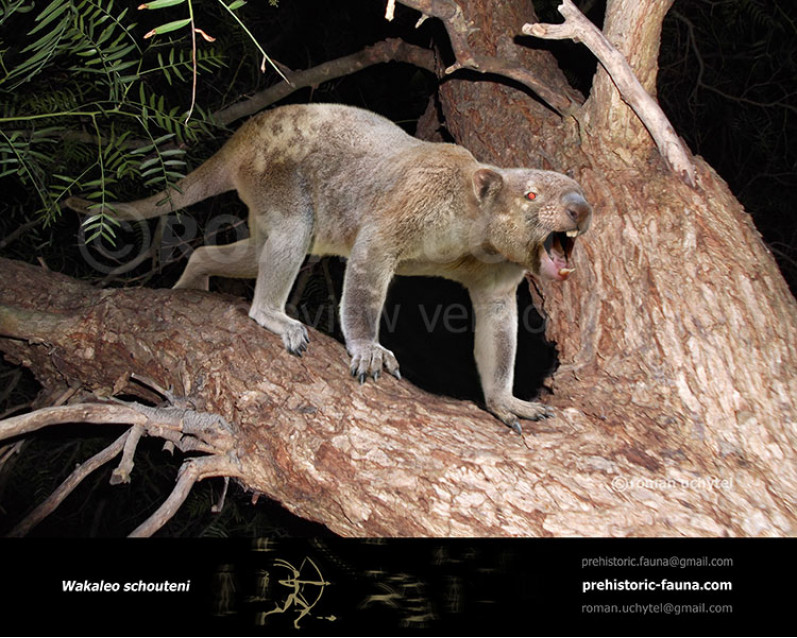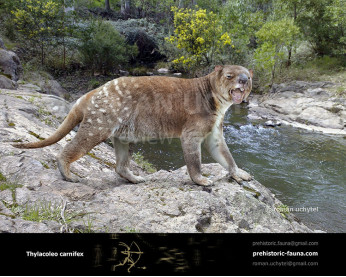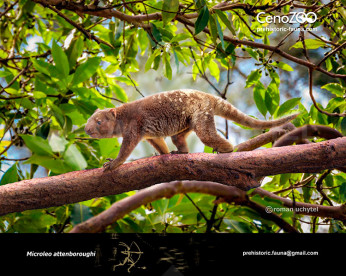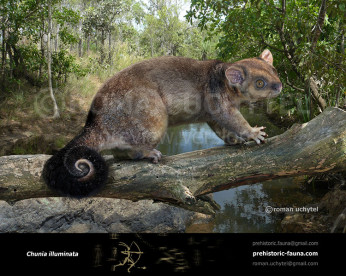Wakaleo schouteni
469469
Wakaleo schouteni (†Wakaleo schouteni (Gillespie))
Order: Diprotodontia
Family: †Thylacoleonidae
Dimensions: length - 60 cm, height - 30 сm, weight - 10-25 kg
Temporal range: lived in Australia in the Miocene (19 million years ago)
The description of the species was published in 2017, the collaborating authors Anna Gillespie, Mike Archer and Suzanne Hand working on the PANGEA research project based at the University of New South Wales. The holotype is a largely complete skull retaining some teeth and alveoli, with other materials such as the lower jaw and a humerus associated with the new species as paratypes.
They were mid-sized predators who probably hunted in trees or ambushed prey from a branch. Calculations of the size following a method of statistical analysis for predicting body size, derived from 164 millimetres for the greatest length of the skull, indicate a weight of 22.6 or 24.0 kilograms. Another estimate using regression equations previously used in calculations of body size for Thylacoleo carnifex, a very large carnivore, resulted in a value around 5 kg that the describing authors considered too small.] The dentition suggests that W. schouteni may have been omnivorous, but reveals the transition to hyper-carnivory of the genus during the Miocene.
The distribution of the species included the Riversleigh World Heritage Area in the northwest of Queensland, at sediments dated to the later Oligocene to early Miocene. The assumption of at least partially arboreal habits is by the forest types that existed during the Oligo-Miocene at Riversleigh, open woodlands with the later development of rainforest. The humerus morphology is proposed to support this conception as a scansorial and arboreal predator, being similar to the structures of the arm and shoulder in species such as Phascolarctos cinereus, the related koala, and spotted cuscus Spilocuscus maculatus.
Payment
You may use multiple payment methods to buy image such as credit cards, PayPal and bank transfer.
Wakaleo schouteni (†Wakaleo schouteni (Gillespie))
Order: Diprotodontia
Family: †Thylacoleonidae
Dimensions: length - 60 cm, height - 30 сm, weight - 10-25 kg
Temporal range: lived in Australia in the Miocene (19 million years ago)
The description of the species was published in 2017, the collaborating authors Anna Gillespie, Mike Archer and Suzanne Hand working on the PANGEA research project based at the University of New South Wales. The holotype is a largely complete skull retaining some teeth and alveoli, with other materials such as the lower jaw and a humerus associated with the new species as paratypes.
They were mid-sized predators who probably hunted in trees or ambushed prey from a branch. Calculations of the size following a method of statistical analysis for predicting body size, derived from 164 millimetres for the greatest length of the skull, indicate a weight of 22.6 or 24.0 kilograms. Another estimate using regression equations previously used in calculations of body size for Thylacoleo carnifex, a very large carnivore, resulted in a value around 5 kg that the describing authors considered too small.] The dentition suggests that W. schouteni may have been omnivorous, but reveals the transition to hyper-carnivory of the genus during the Miocene.
The distribution of the species included the Riversleigh World Heritage Area in the northwest of Queensland, at sediments dated to the later Oligocene to early Miocene. The assumption of at least partially arboreal habits is by the forest types that existed during the Oligo-Miocene at Riversleigh, open woodlands with the later development of rainforest. The humerus morphology is proposed to support this conception as a scansorial and arboreal predator, being similar to the structures of the arm and shoulder in species such as Phascolarctos cinereus, the related koala, and spotted cuscus Spilocuscus maculatus.


-797x638.jpg)

-70x56.jpg)

1-346x277.jpg)

